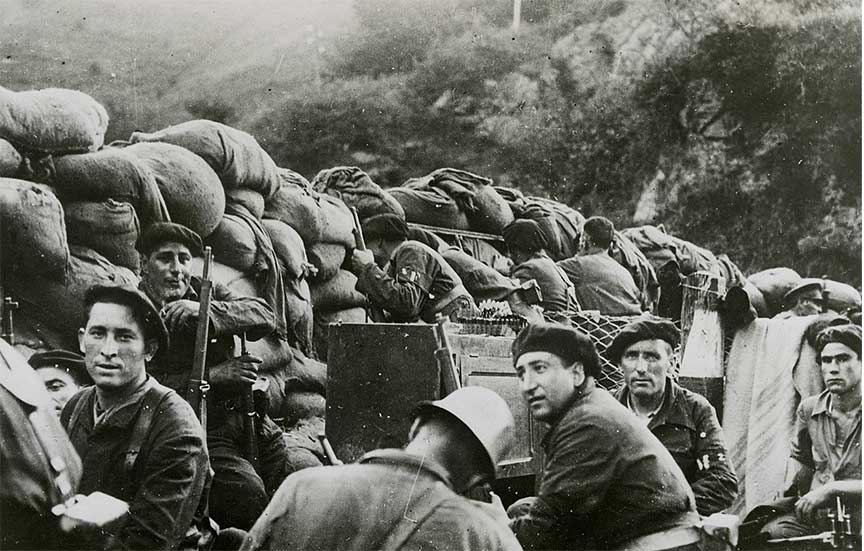Spanish Civil War Begins

Republican Forces
The Spanish Army, led by General Franco with support from the Catholic church and the Monarchists, began a revolt against the democratic government of Spain. The revolt was opposed by government Loyalists and civil war broke out.
In reality, the war became a surrogate war for the European Fascists, with Germany and Italy giving open aid to the Spanish Fascists and the Soviet Union aiding the Loyalists. The rest of Europe followed a policy of neutrality, denying the legitimate government of Spain the arms it needed to defend itself..
On February 16, 1936, elections were held in Spain. The Popular Front coalition of parties of the Left won a decisive victory, securing 265 seats in the Parliament. The right parties, which included the Basque Nations, won 165, and the Center parties won 66 seats. Among the left parties, the left-leaning Republicans won the greatest number of seats at 136, the Socialists won 87, and the Communist acquired only 15. l
Gil Robles, the head of the Righties parties, went to see Prime Minister Manuel Portela and ask him to declare martial law to stop the Left from coming to power.
Robles allies himself with General Franco, the Chief of the Spanish Armed forces. Franco also tried to convince Portela to declare martial law. General Goded, another senior General, tried to get the Spanish troops in the capital to leave their barracks and seize power, but when the civil guard made it clear that they would oppose such a move, the troops refused.
On February 19, after ignoring the pleas to declare martial law, Portela handed over the Premiership to Manuel Azana.
One of Azana’s first acts was to relieve Franco of his post of Chief of Staff and assign him the role of Military governor of the Canary Islands. Azana announced major reform, including land reform changes in taxation and large-scale public works programs to address unemployment.
While Azana pleading for calm, there were prison riots followed by land riots where large estate holdings were seized. Soon chaos developed as fascist vigilante groups, including the Falange Espagnola, fought with leftists on the streets.
On April 10, the President of Spain Niceto Alcala-Zamora was dismissed by Parliament. On May 10, 1936, Anzana became President, and Santiago Quiroga, a Marxist, became the Prime Minister. For a short period, things seemed to be calming down, but on July 12, a police officer sympathetic to the Left was assassinated, and soon after, a leading rightest Calvo Sotelo was killed in the course of an attempt to arrest him.
The army decided to intervene, and on July 18, the Spanish Morrocan Army led by General Franco seized the city of Melila. They soon went on to capture all of Spanish Morrocco. The army seized power in a number of cities in Spain, including Seville, Cadiz, Saragossa, and Pamplano, and Franco put himself as the head of an insurgent government. However, most of the people supported the elected government, and ‘They shall not pass’ soon became the rallying cry of the Republic. Supporting the government were Liberals, many Catholics, Socialists, Communists anarchists, the Civil Guard, the Navy, and Basque Separatists, who supported the government due to the government support of Basque autonomy. Franco had the support of the large landowners, the Catholic hierarchy, the peasants, and the middle class. Franco was confident he would take Madrid and gain quick control of the country. He told Jay Allen and American Journalist on July 26, “ There will be a compromise, no truce, I shall go on preparing my advance on Madirs, I shall advance. I shall take the capital. I shall save Spain from Marxism at whatever the cost. Franco appealed for help from Nazi Germany and Italy, who sent his army arms. The government relied on locally produced arms and arms from the Soviet Union.
The conflict soon became depicted as one between Fascism vs. Democracy. Franco has hoped to conquer Madrid by November 8, and his forces reached the outskirts of the city on the 7th. However, the Spanish government was being aided by an international brigade of volunteers. There were 10,000 volunteers, 2,800 American volunteers members of the Abraham Lincoln Brigade as well 3,000 Soviets, including 1,000 pilots, 2000 British volunteers, and more from a wide range of countries.
The addition of the volunteers was enough, at least for a period, to stem the tied and fight Franco’s troops to a standstill.
 >
>